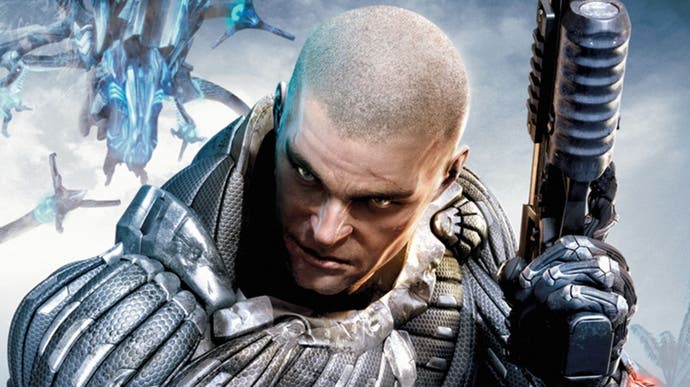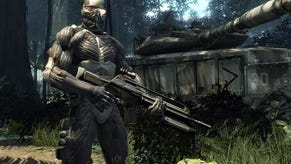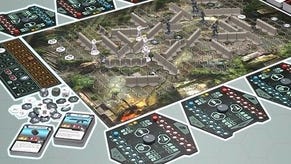2020 Vision: Crysis Warhead - revisiting the forgotten sequel
Did attempts to 'fix' the original ultimately backfire?
Crysis is legendary, seared into the mind of a PC generation - but one chapter of the saga is at best neglected, at worst all but forgotten. Crysis Warhead is a PC exclusive standalone, released just under a year after the original, unclouded by the change of ambition and setting brought about by the multi-platform orientated Crysis 2. With Crysis Remastered looming on the horizon, we wanted to look back at the game, to get a handle on its successes and failures and to answer the question: why is Crysis Warhead so often overlooked?
Warhead is both a continuation and an expansion for the original release but also a response to its many criticisms. Firstly, in terms of design, it attempts to address core criticisms to the gameplay of Crysis itself. While I may personally look back at the original game in its entirety rather fondly, a number of players and reviewers disliked the last third of the game, where you engage the alien threat in a more linear fashion. The freeform 'wide linear' gameplay Crysis was feted for was all but forgotten, while the aliens themselves were perhaps rather one-note.
Then there were the technical challenges in running the game that became the series' hallmark. Beyond gameplay critiques, Crysis' lofty system requirements and ultra-high end graphics didn't go down well with users and reviewers of the time, to the point where even one of the best cards of the era - the GeForce 8800 GT - could struggle. Indeed, even turning up graphics to very high didn't deliver a playable experience on any but the most powerful 8800 GTX or SLI set-ups back in 2007. Even then, a number of levels strained the CPU due to Crysis being a very single-threaded game - even with overclocks, CPUs like the Q6600 would struggle to do much on the highest settings in levels like Ascension. Indeed, as we've demonstrated in the past, even modern PCs with top-tier processors have a hard time delivering consistent performance.
Beyond that, there were concerns from Crytek itself based return on investment - ROI. Crysis sold nearly one million copies in two months, but it was also reportedly one of the most pirated games ever, with Crytek CEO Cevat Yerli claimed that there was a 20:1 ratio of pirates to paying customers. Understandably, spending $22m on a multi-year development for a single platform presents issues if the vast majority of your players are acquiring the game for free.
Crysis Warhead was an attempt to remedy all of these issues. It was the first title to utilise its new multi-studio strategy, with development primarily driven by Crytek's new Budapest-based satellie studio - albeit with support from the Frankfurt mothership. The new game started production in May 2007, going gold in August 2008. To address piracy concerns, somewhat heavy and oppressive SecuROM DRM was added, limited to just five activations. Thankfully, changes to the game to tackle the other issues were handled more comprehensively and with less of a sledgehammer approach.
From a design perspective, Warhead addressed the alien controversy by integrating them into the main combat and gameplay scenarios that the first game was lauded for. Perhaps taking inspiration from Halo, alien encounters were more free-form and engaging, with main protagonist Psycho able to mix it up with both xenomorphs and North Koreans in the same combat scenarios - something we didn't see in the first Crysis. AI also opened up, with more interesting behaviour from the Nanosuited North Koreans and revamped aliens, including new types not seen in the original game.
From a performance and optimisation perspective, Crytek needed to optimise but it could also lean into the arrival of a new generation of GPUs. The Nvidia GTX 280 delivered a 55 per cent performance bump compared to the last-gen 8800 GTX flagship, with the GTX 270 still up to 29 per cet better than the same card. Unfortunately, there was no similar uplift in CPU performance, despite the arrival of the incredible Core i7 920 based on Intel's groundbreaking Nehalem design. The CPU world was moving wider, delivering more cores and threads, as opposed to concentrating on single-thread performance and frequency where CryEngine 2 would stand to benefit more.
Crytek's response for Warhead was twofold. First of all, perception of the settings would change and specific optimisations were made to target the realities of PC games machines, but without having to rework the whole engine. Addressing user perception, Crytek simply renamed the settings. Instead of low, medium, high and very high, Crysis Warhead offered by minimum, mainstream, gamer and enthusiast. It was an attempt to stop a phenomenon that still happens today - the sense of entitlement that any games PC should run well at ultra settings. Changing the names of the settings served to highlight what kind of hardware should actually be used for each preset.
This particular change was only skin deep, and Crytek also used the change in naming convention to actually push certain quality settings higher. If you go through the setting variables side by side between Crysis and Warhead, the original game's very high preset actually had shorter draw distances for detail and vegetation than Warhead at its enthusiast equivalent. There was some genuine optimisation though, including attempts to reduce the AI cost for the CPU. Shader optimisations were also designed to speed up GPU rendering - and those same enhancements made their way back into the original Crysis via patches.
Other performance wins in Warhead came via changes in level design. Crysis Warhead avoids massive vista scenes heavy on drawn objects, vegetation and AI. By extension, there's no VTOL section in Crysis Warhead either (so no scope for performance plummeting per the original's Ascension level). Combat encounters are large, wide and long - but broken up more often by intervening terrain. In general, all of these changes combined make the game less oppressive on GPU and CPU. To illustrate, the original's Ascension can still dip into the mid-30s on a Ryzen 3900X with 3200MHz DDR4 - and we've even logged a similar result on a Core i7 8700K overclocked to 5.0GHz. Meanwhile, the worst we saw in Crysis Warhead on the same Ryzen set-up was a split-second drop to 40fps that swiftly corrected itself, taking us back up to 60fps and beyond.
Fundamentally though, it's still running on the same engine and it's still an offshoot of the original game, so everything Crysis does well, Warhead can match. Outdoor areas still look great today: Crysis effectively communicated the feel and ambience of dense forest and vegetation and Warhead continued this tradition with a few embellishments of its own. When staring at the jungle floor in Warhead, the ground is marked with 3D-like terrain from parallax occlusion mapping. On top of that is another layer of scattered geometric detail for fallen and wither leaves and twigs. Following that, other smaller new details like tiny fungi can be seen. When you turn off the HUD and just sit there, the denseness of the frame and the atmospheric sounds really communicate the feeling of being in the wilderness.
The inclusion of fauna as well as flora is also a nice touch: the chickens in Crysis are famous but Warhead gifts us tiny treehopper frogs that bounce around on the ground and look surprisingly realistic in motion thanks to the great per-object motion blur. There are also overly large spiders creeping along the jungle floor, while rats infest the dank corners of indoor habitats and sewer-like locations. Warhead's snowy environments are also a highlight, thanks in small part to a new thick ice surface shader that seems to have a certain kind of parallax depth to it. This effect is used across the massive frozen waves in the hovercraft chase and in the ice cave used when you transition across from one part of the mountain to the other. It is not just the ice shader which makes it looks so interesting, but the fact that this cave is generated in the editor through use of voxels, which could be used to deliver horizontal holes in terrain - something normal height maps cannot achieve. It was not used very often in-game, but when you do see it, it really looks great.
Beyond purely graphical features, Warhead also uses CryEngine 2's ability to render large worlds in ways we don't often see in games, best represented by the train section, where most of the action plays out as the train itself careers through the level. It's a classic gaming set-up seen in many titles and it's usually delivered via a thin 'tunnel' of linear detail, often with repeating of procedurally created geometry to deliver the feeling of travel. Warhead takes a more Crysis-like approach to the concept where you can move about the train manning its various gun emplacements, but at the same time it is actually moving through real terrain. You can get off at any moment you wish and then speed-run up back to the train to follow it to its destination. While on the train, it even stops, allowing you to infiltrate a base full of enemies blocking your progress. In short, the path is wider and more freeform, with a definite Crysis-like 'wide linear' combat sandbox built into it.
While the game plays on the strengths of the original Crysis with visuals and gameplay, not everything is perfect. One of the greatest strengths of Crysis was the blend of cinematics in first person and first-person gameplay. Crysis Warhead instead utilises cutscenes primarily from third-person cameras - this generally gives the game cinematics a more disconnected feel by comparison, compounded by the more lacklustre animations found in these sequences. This doesn't seem to be a technical limitation, and perhaps it's down to time and budget instead.
Being on CryEngine 2 also means it inherits some of the technical weaknesses from the first game - specifically indoor scenes. While Crysis 1 pioneered screen-space ambient occlusion (SSAO), it did not have any real bounce lighting - just a flat ambient colour in shadows. This worked well enough for outdoor areas, but indoor locations that lack direct lighting and shadows look rather odd. There's a sense of discontinuity here: the mine areas in Warhead look great with their harsh lights, shadows and volumetric lighting, but the areas inside the North Korean bases that lack shadow maps look rather flat.
Then there is the general change in colour tone from the original. For all of Crysis' emphasis on post-processing, it actually featured very natural colour tones and image processing. Outdoor scenes and their colour temperature and curves were modelled on photography and not ultra stylised, giving a very realistic look. Crysis Warhead is punchier, with time of day is typically set to dusk or daybreak. Combined with what looks like tweaked post-processing, some scenes exhibit what looks rather like black crush, in contrast to the original game's more natural palette.
It's still very much a Crysis game though and I do recommend trying it out today - but I would recommend some tweaks. First of all, visit the PC gaming wiki and download the parallax occlusion mapping AF fix - which allows anisotropic filtering and POM to live together wihout issue. If you're using HDMI, Crysis and Warhead may try to default to 24fps. Pressing Alt-Enter a few times may fix this but if doesn't, try setting up a custom resolution the GPU control panel - 1918x1080 for 1080p, for example, at 60Hz. This should solve the issue. I'd also recommend using the 64-bit .exe - it runs better in CPU-limited scenarios and presents fewer issues on modern PCs, particularly with AMD processors. Then I'd recommend using my personal autoexec, dropped into the game's main folder. It improves shadow resolution, applies shadows to certain particle effects and prevents texture streaming - since modern GPUs have more than enough memory to cope without it.
Ultimately, Crysis Warhead achieved its primary objectives - it ran better than the first game and was a less risky release given its development time frame. At the same time, some of the changes it made hinted at the direction Crytek chose to pursue with further titles in the series. Warhead's graphics settings were designed to catering to a more mainstream specification, something Crytek would double-down on in Crysis 2. While this pseudo-sequel was still very much in the mould of the original, the more constrained combat scenarios do not impress as much - or offer as much player freedom or replayability as classic maps from the first game like Recovery, Relic, Assault, and Onslaught.
And perhaps this is the reason why Warhead is more of a footnote in Crysis history rather than a celebrated chapter. The original was a game with unrivalled ambitions for graphics and simulation, while its massive, wide-linear sandbox levels are still fondly remembered today. Warhead still enjoyed a high level of quality, but toned down, diluted variants of the original are less impressive - and certainly not genre-defining like the original, which threw all caution to the wind. We can also assume that Warhead wasn't quite the commercial success Crytek may have hoped for. PC exclusivity ended, level design grew more constrained and the aliens evolved from fast-moving flying creatures into the more conventional bipedal foes in Crysis 2 and 3. Crysis moved on - but perhaps lost some of what made it special in the first place.
All of which brings us to the new Crysis Remastered, coming this summer. Despite talk of 'campaigns' in the plural in the initial PR, Crytek has since confirmed that it's just the original game receiving the update and that the Warhead levels won't make it into the new release. But what we should get is still mouthwatering - the original Crysis, brought up to date with cutting-edge visuals, but still possessing the 'wide linear' sandbox shooting that still feels great today. It's a chance to reboot the franchise for the next generation, and I can't wait to see what Crytek and Saber Interactive deliver.


















